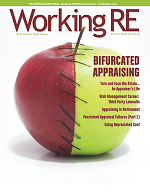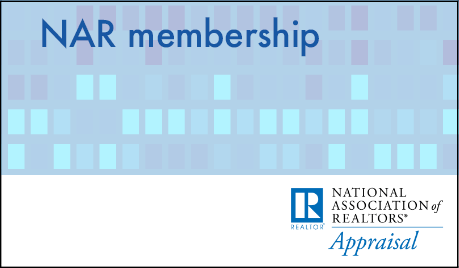 |
“One of the best courses that I have had in 17 years!” -Amy H.
|
De Minimus Raised
by Isaac Peck, Editor
Earlier this week the Federal Deposit Insurance Corporation (FDIC) approved a final rule officially raising the appraisal de minimus from $250,000 up to $400,000. The de minimus threshold is the minimum transaction amount below which an appraisal is not required for federally related residential real estate transactions.
Since 1994, an appraisal is required for any federally-related residential real estate transaction at or above the de minimus threshold of $250,000. Now, 25 years later, the de minimus has finally been raised to $400,000.
Background
The idea of raising the de minimus was first proposed jointly by the FDIC, the Office of the Comptroller of the Currency (OCC), and the Federal Reserve, on November 20, 2018.
The Appraisal Institute (AI) issued a strong criticism with 2018 AI President James L. Murrett MAI, SRA writing that such a move “recreates the same type of environment that led to the housing crisis” and threatens the “vital role that appraisers play in real estate transactions.” Murrett further noted, “Raising the threshold means more evaluations will be allowed in place of appraisals. The Appraisal Institute anticipates that will result in a return to the production driven lending environment seen during the lead up to the financial crisis, where appraisal and risk management were thrust aside to make more—not better—loans. Apparently, the FDIC has learned nothing from that experience.”
Evaluations
With a higher appraisal de minimus, AI believes evaluations will become more prevalent in the market. Evaluations are short-form property valuations, similar to a Broker Price Opinion, and they are not required to be performed in accordance with USPAP or by state certified appraisers. Title XI valuation requirements require that evaluations be “performed by persons who are competent and have the relevant experience and knowledge of the market, location, and type of real property being valued,” but those individuals are not required to have any state license to perform this work. But bizarrely those most qualified to do them, licensed appraisers, are barred from completing evaluations in most states: they are only allowed in Tennessee, North Carolina, Virginia, and a handful of other states where appraisers have recently banded together to pass legislation that specifically exempts appraisals from USPAP when performing evaluations.
For this reason, both AI, the National Association of Appraisers (NAA), and many state appraiser coalitions have been actively lobbying their state legislatures to exempt appraisers from USPAP when performing evaluations, which would open up this line of work to appraisers and expand, rather than constrict, the number of assignments available to appraisers.
In an article published in Working RE’s Summer issue, Craig Morley, President of the NAA, writes that “many lenders do not want an Appraisal, they want an Evaluation specifically
due to the way federal regulators look at that valuation service differently.” Morley explains that the goal of the NAA’s work to get legislation passed in Utah and other states is “to provide a way for the licensed professionals most qualified to provide these valuation services, appraisers, to be able to do so if they so choose.”
Effect on Appraisal Industry
While appraisers and appraisal organizations are understandably alarmed by the raising of the de minimus, a deeper analysis suggests that it will have a muted effect on the appraisal industry, at least initially.
(story continues)
In their November 2018 proposal, the agencies argued that the increase will not have much effect on the real estate market because currently 56 percent of all federally regulated residential real estate transactions are exempt from appraisal requirements, as they fall below the $250,000 de minimus. Raising the de minimus to $400,000 would increase exemptions to 72 percent.
In 1994 when the de minimus was increased to $250,000, it resulted in an “aggregate dollar volume of exempted transactions up to 85 percent of all new home sales, and 82 percent of all existing home sales.” Consequently, regulators “expect the proposed threshold level to have a much smaller impact on the dollar volume of transactions and, therefore would be less likely to pose a safety and soundness risk than the current threshold level did when it was introduced in 1994.”
More importantly, the raising of the de minimus begs the question as to what percentage of mortgages nationally will be effected. The agencies argue quite convincingly that the impact of this rule will have almost no effect on the real estate market at large, because a majority of residential real estate transactions “are sold to the GSEs or otherwise insured or guaranteed by a U.S. government agency.”
The estimated impact of the proposal, they write, will be only “three percent of all first-lien, single family mortgage transactions in the United States.” This is due, in part they say, because 91 percent of all mortgages are not currently subject to the $250,000 de minimus “due to their not being originated by regulated institutions, being sold to the GSEs or otherwise insured or guaranteed by a U.S. government agency, or having transaction amounts at or below the current $250,000 threshold.”
In other words, all loans purchased by Fannie Mae and Freddie Mac or insured or guaranteed through the Federal Housing Administration (FHA), Veteran Affairs (VA), and other government agencies, are already exempt from the de minimus requirements, and as such the majority of mortgages made in the U.S. will not be effected by this latest rule.
Additionally, in the issuance of the final rule, the agencies note that a five-year review on the use of appraisals and evaluations by large financial institutions “found larger lenders obtained appraisals on 74 percent of portfolio residential real estate originations at or below the current $250,000 threshold.” The agencies write that this data suggests that lenders are “often exercising discretion in determining when to use evaluations” and also suggests that lenders are still ordering appraisals even though not required.
Looking to the Future
The impact of this latest rule change then, while still negative for appraisers, may not be as significant as many appraisers perceive. With the vast majority of mortgages already exempt from the de minimus by virtue of being (1) already below the $250,000 threshold, (2) sold to the GSEs, or (3) being insured by a government agency (VA, FHA, etc), the latest change to the de minimus is bad for appraisers, but still mostly symbolic.
(story continues)
Fannie Mae and Freddie Mac are reportedly issuing Appraisal Waivers for 5-10% of mortgages currently and have been teasing an announcement to bifurcate the appraisal process and begin accepting Property Data Collections in lieu of appraisals in certain circumstances.
VA appraisals also are now being pushed towards the hybrid/bifurcated model due to a recent law passed in Congress. In June 2019, Congressional Bill H.R. 299, the Blue Water Navy Vietnam Veterans Act of 2019, included a provision that mandates that the VA “shall permit” the use of bifurcated/hybrid appraisals. It will take effect as law on January 1, 2020. Specifically, the law amends title 38 of the United States code as follows: “(3) The Secretary shall permit an appraiser on a list developed and maintained under subsection (a)(3) to make an appraisal for the purposes of this chapter based solely on information gathered by a person with whom the appraiser has entered into an agreement for such services.” The Secretary of VA is currently working on issuing guidance to implement rules around these hybrid appraisals.
Consequently, the real threat to the appraisal industry and to appraisers’ ability to earn a livelihood is coming not from the FDIC, but from the GSEs and other government agencies, as they (1) control the majority of the mortgage market, and (2) are already exempt from the de minimus.
This is a developing story. Look for Working RE print, mailing soon, that includes in-depth analysis of Fannie’s push for bifurcated appraisals. OREP insureds enjoy guaranteed delivery of every print issue along with new lower premiums, free BIPD and a zero deductible (most policies). If you’re not an OREP insured, you can subscribe here. (Am I a Working RE Subscriber?)
CE Online – 7 Hours (AQB Approved)
Identifying and Correcting Persistent Appraisal Failures
Richard Hagar, SRA, is an educator, author and owner of a busy appraisal office in the state of Washington. Hagar now offers his legendary adjustments course for CE credit in over 40 states through OREPEducation.org. The new 7-hour online CE course Identifying and Correcting Persistent Appraisal Failures shows appraisers how to avoid CU’s red flags, minimize callbacks, save time, and earn more! Learn how to improve the quality of your reports and build defensible reports! OREP insureds save on this approved coursework. Sign up today at
www.OREPEducation.org.
Sign Up Now! $119 (7 Hrs)
OREP
Insured’s Price: $99
About the Author
Isaac Peck is the Editor of Working RE magazine and the Vice President of Marketing and Operations at OREP.org, a leading provider of E&O insurance for appraisers, inspectors and other real estate professionals in 50 states. He received his master’s degree in accounting at San Diego State University. He can be contacted at isaac@orep.org or (888) 347-5273.
>Opt-In to Working RE Newsletters
>Shop Real Estate Agent Insurance
Send your story submission/idea to the Editor: isaac@orep.org





by Michael Ford, AGA, SCGREA, GAA, RAA, Realtor®
When sub-standard services like evaluations are sought purely to lower costs associated with appraisals, the solution is not to lower appraisal standards. Nor is it to lower the expected quality required of appraisers so that they can compete by performing garbage quality reports currently being performed by non-appraisers.
By itself, it is simply a bad idea. It also contradicts the original reasons claimed by AI legislative lobbyists that sought to get legislation approved to permit this, state by state.
In the current environment where bifurcated hybrid appraisals are also being sought (which will be called appraisals), the actual standard of performance is typically just as low as that associated with evaluations. In fact, some of the languages within these universally deficient products refer to them as both appraisal and evaluation, resulting in a perception among investors and securities bundlers that both are mere ‘some undefined type of abbreviated’ product that is just as credible as a ‘real appraisal’.
High volume national appraisal factories or appraisal mills want to use low paid trainees to do the grunt work of analysis, signing behind inspectors with inadequate training, to produce a product that pretends to be an appraisal, while having no more credibility than an evaluation.
For ‘clients that demand’ cheaper products than trained professionals can provide while adhering to all accepted MINIMUM standards (USPAP) the answer should be “fine. You can have evaluations provided by untrained, non-appraisers. Just don’t tell your investors that the securities are backed by credible appraisals.
A relatively few special interest high volume value-production mills should not be entitled to destroy an entire profession, nor eliminate meaningful standards of performance.
-